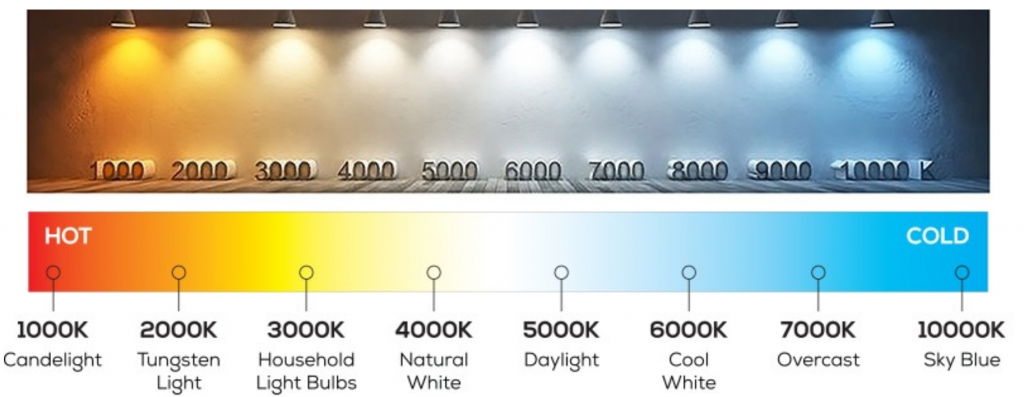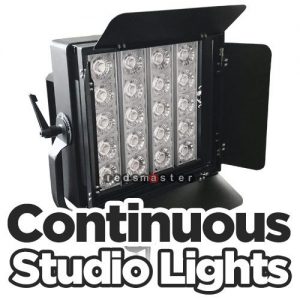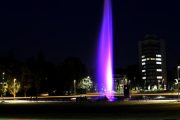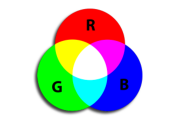What is Color Temperature
Color temperature is the most common indicator for the spectral quality of a light source, and it is a unit of measurement that indicates the color components contained in the light. It is generally expressed by Tc. Theoretically speaking, the black body temperature refers to the color of the absolute black body after being heated from absolute zero (-273°C). After the black body is heated, it gradually turns from black to red, turns yellow, turns white, and finally emits blue light. When heated to a certain temperature, the spectral component of the light emitted by the black body is called the color temperature at this temperature, and the unit of measurement is “K” (Kelvin).
If the light emitted by a light source has the same spectral components as the light emitted by a black body at a certain temperature, it is called a certain K color temperature. For example, the color of the light emitted by a 100W bulb is the same as that of an absolute black body at 2527°C, then the color temperature of the light emitted by this bulb is: (2527+273) K=2800K.
Nowadays, LED lamps are very common in life. There are various colors, so how much LED color temperature is good for the eyes? Are led lights harmful to eyes? The author will explain it for everyone, let’s take a look.
Too High Color Temperature Can Damage the Retina
Experts suggest that high color temperature will damage the retina. Therefore, it is recommended to use three-primary-color light source lighting equipment for home lighting. Red, green and blue are the three basic colors. The three-primary color lighting equipment has the characteristics of soft light, uniform brightness, no flicker, and no glare. Therefore, it is widely used in school and home lighting equipment, and the color temperature of table lamps should not exceed 4000k.
In general, the product manual of the bulb will mark the basic parameters of light source type, color temperature, illuminance, and strobe. In the family, you can also use some color temperature comparison charts, which are the red-orange-yellow-green sequence that we often see, and the color of light. It is related to the color temperature of the lamp. If the color temperature is high, it will be too white and too dazzling. If the color temperature is low, it will tend to yellow-red, which will easily cause sleepiness.
It is easy to distinguish at home. If the light turns yellow-red, its color temperature will be low. The sun in one hour after sunrise is about 4000k. The color temperature of 4000k will make people feel warm when awake. Reading and studying under this color temperature will bring peace of mind and high learning efficiency.
At present, some desk lamps on the market have a higher color temperature, which is harmful to the retina, which can lead to macular degeneration and increase in free radicals. It is also a risk factor for myopia. At the same time, using it at night can inhibit the secretion of melatonin, interfere with the biological clock, and is detrimental to the child’s physical and mental development.
Parents should check the specific color temperature of the table lamp used by the child, and if the light source used does not meet the requirements, it should be replaced as soon as possible. At the same time, parents are reminded that if the ceiling light of the learning room does not meet the relevant requirements, it is not a three-primary light source, and it should be replaced as soon as possible.
What LED Color Temperature is Good for the Eyes?
There are reports that cold white LEDs and blue LEDs are harmful to the eyes and should be banned. These LEDs are mainly used for decoration, and the intensity of blue light emitted by them far exceeds that of natural lighting and traditional lighting. These high-intensity blue light will cause damage to the pigment epithelium of the retina and the sensory layer of the retina at the same time, thereby accelerating retinal aging and increasing the risk of macular degeneration. The biggest victims of LEDs are children under 10 years old. Children of this age have neither cloudy lenses nor macular pigment, so they lack the ability to resist blue light.
The LED lamp uses a blue chip and an external yellow phosphor to produce white light, which makes the content of blue light in the LED lamp relatively high. Blue light refers to the blue light band of 400-500 nanometers. If the brightness is too high, the eyes may cause photochemical damage to the retina after looking directly at the light source for a long time. The degree of blue light hazard depends on the accumulated blue light dose received by human eyes under light. According to the regulations of the International Lighting Electrical Association, the color temperature of LED lamps cannot be greater than 4000K when used for lighting purposes. However, due to the high light efficiency and relatively low cost of high color temperature LED light sources, there are many high color temperature products on the market.
Color temperature is the most common indicator of light source spectral quality. “Warm light” has a low color temperature, while “cold light” has a relatively high color temperature. When the color temperature increases, the proportion of blue light radiation increases, and the blue light increases accordingly. At the same time, brightness also affects the proportion of blue light. Generally speaking, fluorescent lamps and LED lamps with the same color temperature are basically harmless as long as the brightness of the latter is not more than three times that of the former. However, for individual LED lamps that are too bright, the proportion of blue light may exceed the safe value. As the LED technology matures, manufacturers no longer need to blindly increase the color temperature and power of lamps to achieve high lumens, and objectively reduce the possibility of excessive blue light.
Are LED Lights Harmful to Eyes?
When parents choose eye protection lamps for their children, they often think that the brighter the light, the better. This reminds me of the story in the 1990s when we thought that the whiter the flour, the better, but now everyone knows that the whitening of flour is due to the addition of whitening. Brighteners are harmful to people. Therefore, to judge whether a thing is good or bad, one must know its internal composition to be sure.
Here I will talk about the basic knowledge of light source. The eye protection lamp protects the eyes because the high-frequency rectifier circuit makes people not feel the flicker of the fluorescence. This is Philips technology in the 1980s, and now all large and small manufacturers can do it. The key to eye protection is the color rendering of the tube and the color temperature of the light. The eye protection lamp uses a fluorescent tube, and the main luminescent materials currently used are pure three-basic color powder, halogen powder and mixed powder of the two.
According to the cost calculation, eye protection lamps with a retail price of less than $15 in the market can basically not be called eye protection lights, because eye protection lights that are not pure tri-color are actually eye-catching lights. Effect. (The price of pure tri-basic toner is nearly 10 times that of halogen powder.) I will not do the analysis here. I will only talk about the color temperature of the pure tri-basic toner tube.
The light of the tri-color tube is the phosphor yttrium oxide (red light, peak wavelength is 611nm) that can emit red, green, and blue light sensitive to the human eye, and magnesium polyaluminate (green light, peak wavelength is 541nm) ) And barium magnesium polyaluminate (blue light, peak wavelength of 450nm) mixed in a certain proportion into three primary color phosphors, so as to emit light closer to sunlight. Color temperature is the perception of human eyes on luminous objects or white reflectors. Normally, from 10 noon to 2 pm, on a clear and cloudless sky, without direct sunlight, the standard daylight is about 5000–5500K. But the light at this time is the most poisonous and dazzling.
Current energy-saving lamps generally use a color temperature of 5500-6500K, and eye protection lamps generally use a color temperature of 4500–5500K. Many of our consumers feel eye pain after reading under a desk lamp. The reason is that the color temperature and color rendering of the desk lamp are not good. Suitable for close reading. It is easy to compare the same book under different color temperature lights. The higher the color temperature, the brighter the light, and the more dazzling the reflected light of writing.
The lower the color temperature, the warmer the yellow light and the softer the reflected light of writing. , The less irritation to the eyes. Through experiments, we can see that the effect of reading is best when the color temperature is around 4000K, and there is basically no reflected glare. And why only a few manufacturers use 4000K color temperature lamps, there are only two reasons: one is that the higher the color temperature of the lamp, the cheaper it is, and the second is that the higher the color temperature, the brighter the light looks, just like a brightener. Like flour, it looks good!
Therefore, remind users of table lamps and eye protection lamps that the brighter the table light line is, the better. The light for reading and learning should be soft. The standard color temperature between 3800–4200K is the most suitable.








